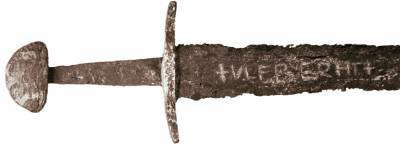You’ve heard of Gucci and Coach purse knockoffs or Rolex watch knockoffs, but have you ever heard of an Ulfberht sword knockoff? Brand knockoffs go all the way back to Viking times! As a person with Scandinavian heritage, I couldn’t resist watching Secrets of the Viking Sword, a NOVA special on PBS.
Turns out, people are people. Whether in the 9th century or the 21st, counterfeiters have always been on a mission to capitalize on the strengths of great branding.
True Ulfberht Swords
Most Viking swords of the time were made of bog iron, which was widely available in Northern Europe. Problem was, these swords were brittle and bent easily. (Who wants to spend a battle constantly using his foot to straighten his blade?) The search was on for a better sword. Better swords meant more conquering, more spoils, and less pain and loss for the sword bearers.
So Ulfberht set out to make the best swords around. (No word on whether Ulfberht was a blacksmith, a blacksmith shop, or a group of tradesmen. Many believe it was a foundry, though it has been long lost to history and never uncovered.)
What made Ulfberht swords different was both the materials used and the process required to create the unbeatable steel. Archaeologists believe the metal used to create these swords was picked up along trade routes through modern day Iran and Afghanistan. By melting the iron in a sealed crucible (a technology brought over from Asia), the resulting steel was purer, with even carbon distribution and an aerodynamic design that was both flexible and sharp. This ancient blacksmithing process has only recently been recreated, after an historical absence of over 1,000 years.
Made of premium materials and forged by master blacksmiths, Ulfberht swords were THE best swords available in 9th to 12th century Viking times. Only the greatest swordsmen could afford an Ulfberht.
Riding the Ulfberht Coattails
With great branding success comes a multitude of copycats. These opportunists created vastly inferior swords with deadly consequences. Unfortunately, the swordsman wasn’t typically aware of his faulty purchase until his brittle sword crumbled in battle, leaving him defenseless. Talk about buyer’s remorse. Sheesh.
Just like today’s “Rollex” knockoffs, counterfeit swords bore the Ulfberht name, but often with a slight spelling shift, to persuade the purchaser. For example, the real Ulfberht sword would be inscribed like so: “+VLFBERH+T” –but the knockoff variety might look something like this: “+VLFBEHT+.” However, it’s possible these illiterate craftsmen didn’t know their spelling was off, and, being that the buyer was also likely illiterate—no one really cared.
After all, branded swords didn’t exist back then, otherwise. So how would you even know to consider that the sword might be a knockoff? Most Vikings, with their limited literary skills, might look at the sword’s lettering and be convinced it was a superior product, simply because the lettering existed at all!
Counterfeiting: Serious Business
“Intellectual property crimes are not victimless. The theft of ideas and the sale of counterfeit goods threaten economic opportunities and financial stability, suppress innovation and destroy jobs.” –U.S. Attorney General Eric Holder
From wine to shoes to medication to food, counterfeit consumer goods are everywhere. Counterfeit goods negatively affect the consumer, as they are purchasing expensive products that are, in fact, the result of shoddy manufacturing and inferior raw materials. But, seeing as these substandard products are sold as a representation of a particular brand, that copied business could also report a loss in consumer trust and company-wide earnings due to (albeit misguided) consumer reactions.
Worst yet, profits from today’s counterfeit operations often support unsavory sorts of people and activities.
Perhaps the reason Ulfberht was never recovered was due to a group of misinformed Viking consumers wreaking havoc on the foundry after a slew of untimely deaths spurred by inferiorly manufactured swords! The world may never know…
Have your ever been the victim of copycat, counterfeit or knockoff product? How was your business affected, or, how were you affected as a consumer? Leave a comment below!

